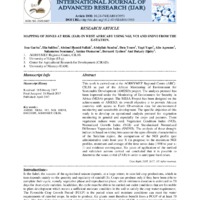Recherche
3 items
Evaluation des ressources pastorales au sahel nigérien à l'aide des données NDVI issues de spot-vegetation et modis
L’étude a été réalisée dans la zone pastorale du Niger, elle se propose de : tester la stabilité du modèle d’estimation de la biomasse du Ministère de l’Élevage et des Industries Animales (MEIA) du Niger ; puis de comparer les performances de l’intégrale et du maximum du NDVI de SPOT VEGETATION et eMODIS à l’aide des données réelles collectées de 2001 à 2012 par MEIA. La méthode de régression linéaire simple est utilisée pour calculer les coefficients de détermination R² et les erreurs quadratiques sur la série (RMSE), par zone bioclimatique puis année par année. Les résultats montrent des R² variant, suivant les années, de 0,52 à 0,73, de façon très significative (P<.0001). Ce coefficient de détermination est plus élevé dans les zones saharienne et nord sahélienne comparé à la zone sahélienne typique. Les RMSE annuelles varient entre 120 et 460 Kg.MS.ha-1. Les tests non paramétriques de comparaison de moyenne (Test de Wilcoxon et des signes) ne mettaient pas en évidence de différence significative entre SPOT VEGETATION et eMODIS (intégrale ou maximum). Cette possibilité d’intercomparabilité des indices provenant de différents capteurs permet aux utilisateurs d’assurer la production sans interruption avec une possibilité d’analyse convergente si l’un des deux capteurs était indisponible.
Mapping of zones at risk in west Africa by using NGI, VCI and SNDVI from the E-Station.
This work is carried out at the AGRHYMET Regional Centre (ARC)-CILSS as part of the African Monitoring of Environment for Sustainable Development (AMESD) project. The analysis protocol has been improved under the Monitoring of Environment for Security in Africa (MESA) project. The MESA Project has been designed on the achievements of AMESD; its overall objective is to provide African countries with access to Earth Observation data for environmental monitoring and sustainable development. The specific objective of this study is to develop an operational analysis protocol for vegetation monitoring in general and especially for crops and pastures. Three vegetation indices were used: Vegetation Condition Index (VCI), Normalized Growth Index (NGI) and Standardized Normalized Difference Vegetation Index (SNDVI). The analysis of these drought indices is based on taking into account the agro-climatic characteristics of the Sahelian region, the comparison of the NGI profile (per administrative unit) from year X (in progress) to the maximum NGI profiles, minimum and average of the time series data (1998 to year x-1) and evidence convergence. Six years of application of the method and validation actions carried out concluded that it is possible to determine the zones at risk (ZAR) in order to anticipate food crises.
Performance of similarity analysis in the estimation of forage yields in the Sahelian zone of Niger
The study aims to test the performance of similarity analysis in herbaceous fodder biomass estimate in the Nigerian pastoral zone, in a context of insecurity and precipitation spatiotemporal variability. It is carried out on the time series of NDVI decadal images of SPOT VEGETATION for the period from 2001 to 2012 and on fodder biomasses measured in situ during the same period. Similarity analysis compares NDVI seasonal patterns to detect similar years using three criteria: the RMSE (Root Mean squared error), the MAD (Mean absolute Deviation), and R². Exploratory statistical analyzes with bootstrap are carried out to better characterize the observations resulting from the simulation. Moreover, the analysis of the parametric and non-parametric correlations is carried out to evaluate the level of link between the simulated data and the real data. The t test and the Wilcoxon test are then carried out in order to compare the means of the actual biomasses with those obtained by the similarity analysis. At the local level, the results indicate that the R² is more efficient than the RMSE and the MAD which have almost the same performances. The results of the similarity calculated with R² can be used as a proxy to the herbaceous phytomass measured in situ, as there is no significant difference between the simulated mean and the mean measured at the 1% threshold. On the other hand, the results of the similarity calculated with the RMSE and the MAD are not exploitable. Parametric and nonparametric correlations are all significant at the 1% threshold. However, the R² are low and vary between 0.32 and 0.45. It therefore seems necessary to continue the research, as numerous studies have revealed very good links between certain indices like the FAPAR, the EVI and the LAI and the aerial phytomasse.


